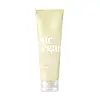What's inside
What's inside
 Key Ingredients
Key Ingredients

 Benefits
Benefits

 Concerns
Concerns

 Ingredients Side-by-side
Ingredients Side-by-side

Water
Skin ConditioningGlycerin
HumectantSodium Cocoyl Isethionate
CleansingHouttuynia Cordata Extract
Skin ConditioningHydroxypropyl Starch Phosphate
Potassium Cocoyl Glycinate
1,2-Hexanediol
Skin ConditioningCentella Asiatica Extract
CleansingBambusa Vulgaris Water
Skin ConditioningChamaecyparis Obtusa Water
MaskingBetula Platyphylla Japonica Juice
Skin ConditioningHouttuynia Cordata Powder
Skin ConditioningMalt Extract
Skin ProtectingGluconolactone
Skin ConditioningPotassium Cocoate
EmulsifyingButylene Glycol
HumectantAcrylates Copolymer
Ethylhexylglycerin
Skin ConditioningDisodium EDTA
Water, Glycerin, Sodium Cocoyl Isethionate, Houttuynia Cordata Extract, Hydroxypropyl Starch Phosphate, Potassium Cocoyl Glycinate, 1,2-Hexanediol, Centella Asiatica Extract, Bambusa Vulgaris Water, Chamaecyparis Obtusa Water, Betula Platyphylla Japonica Juice, Houttuynia Cordata Powder, Malt Extract, Gluconolactone, Potassium Cocoate, Butylene Glycol, Acrylates Copolymer, Ethylhexylglycerin, Disodium EDTA
Water
Skin ConditioningGlycerin
HumectantAcrylates Copolymer
Potassium Cocoyl Glycinate
Disodium Cocoamphodiacetate
CleansingPotassium Cocoate
EmulsifyingSodium Cocoyl Alaninate
Panthenol
Skin Conditioning1,2-Hexanediol
Skin ConditioningSodium Chloride
MaskingSodium Hydroxide
BufferingSodium Methyl Cocoyl Taurate
CleansingCaprylyl Glycol
EmollientZea Mays Starch
AbsorbentMicrocrystalline Cellulose
AbsorbentMannitol
HumectantButylene Glycol
HumectantGlycoproteins
Skin ConditioningHydroxypropyl Starch Phosphate
Hexylene Glycol
EmulsifyingSodium Phytate
Gluconolactone
Skin ConditioningEDTA
Tocopheryl Acetate
AntioxidantCI 77289
Cosmetic ColorantWater, Glycerin, Acrylates Copolymer, Potassium Cocoyl Glycinate, Disodium Cocoamphodiacetate, Potassium Cocoate, Sodium Cocoyl Alaninate, Panthenol, 1,2-Hexanediol, Sodium Chloride, Sodium Hydroxide, Sodium Methyl Cocoyl Taurate, Caprylyl Glycol, Zea Mays Starch, Microcrystalline Cellulose, Mannitol, Butylene Glycol, Glycoproteins, Hydroxypropyl Starch Phosphate, Hexylene Glycol, Sodium Phytate, Gluconolactone, EDTA, Tocopheryl Acetate, CI 77289
 Reviews
Reviews

Ingredients Explained
These ingredients are found in both products.
Ingredients higher up in an ingredient list are typically present in a larger amount.
1,2-Hexanediol is a synthetic liquid and another multi-functional powerhouse.
It is a:
- Humectant, drawing moisture into the skin
- Emollient, helping to soften skin
- Solvent, dispersing and stabilizing formulas
- Preservative booster, enhancing the antimicrobial activity of other preservatives
Acrylates Copolymer is used as a film-forming agent and texture enhancer.
After applied, Acrylates Copolymer forms a thin film cover that helps skin feel more soft. It can help sunscreens become more water-resistant.
It is also used to make a product more thick.
Learn more about Acrylates CopolymerButylene Glycol (or BG) is used within cosmetic products for a few different reasons:
Overall, Butylene Glycol is a safe and well-rounded ingredient that works well with other ingredients.
Though this ingredient works well with most skin types, some people with sensitive skin may experience a reaction such as allergic rashes, closed comedones, or itchiness.
Learn more about Butylene GlycolGluconolactone is a PHA. PHAs are a great gentle alternative to traditional AHAs.
When applied, Gluconolactone has the same affect on skin as AHAs such as lactic acid. It helps dissolve the dead skin cells in the top layer of your skin. This improves texture and brightens the skin.
PHAs are more gentle than AHAs due to their larger structure. They do not penetrate as deeply as AHAs and take a longer time to dissolve dead cells. Studies show PHAs do not cause as much irritation.
Gluconolactone has some interesting properties:
In a 2004 study, Gluconolactone was found to prevent UV damage in mouse skin cells and has not been found to increase sun sensitivity. However, we still recommend wearing SPF daily.
This ingredient is is an created by reacting gluconic acid with an alcohol.
Learn more about GluconolactoneGlycerin is already naturally found in your skin. It helps moisturize and protect your skin.
A study from 2016 found glycerin to be more effective as a humectant than AHAs and hyaluronic acid.
As a humectant, it helps the skin stay hydrated by pulling moisture to your skin. The low molecular weight of glycerin allows it to pull moisture into the deeper layers of your skin.
Hydrated skin improves your skin barrier; Your skin barrier helps protect against irritants and bacteria.
Glycerin has also been found to have antimicrobial and antiviral properties. Due to these properties, glycerin is often used in wound and burn treatments.
In cosmetics, glycerin is usually derived from plants such as soybean or palm. However, it can also be sourced from animals, such as tallow or animal fat.
This ingredient is organic, colorless, odorless, and non-toxic.
Glycerin is the name for this ingredient in American English. British English uses Glycerol/Glycerine.
Learn more about GlycerinHydroxypropyl Starch Phosphate is a modified starch used to help thicken a product.
It is also used in foods.
This ingredient is the potassium salt of coconut acid. Coconut acid is created by mixing fatty acids from coconut oil.
It is an emulsifier, surfactant, and cleanser. According to a manufacturer, it contains glycerin.
Potassium Cocoyl Glycinate is an amino acid-based surfactant and cleaning agent. This ingredient can be derived from animals or plants. It may also be synthetically created from fatty acids of the coconut and glycine.
Potassium Cocoyl Glycinate is a gentle surfactant. Surfactants help gather the dirt, oil, and other pollutants from your skin to be rinsed away. It is a mild cleanser and naturally produces foam.
Water. It's the most common cosmetic ingredient of all. You'll usually see it at the top of ingredient lists, meaning that it makes up the largest part of the product.
So why is it so popular? Water most often acts as a solvent - this means that it helps dissolve other ingredients into the formulation.
You'll also recognize water as that liquid we all need to stay alive. If you see this, drink a glass of water. Stay hydrated!
Learn more about Water